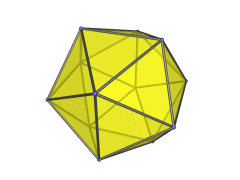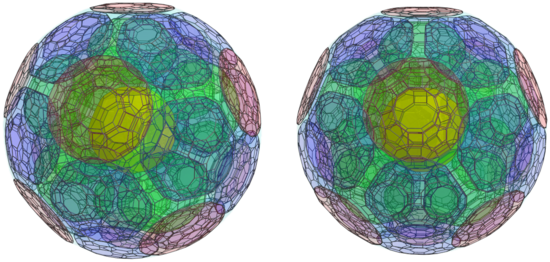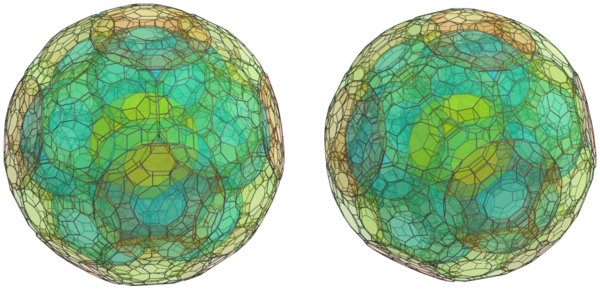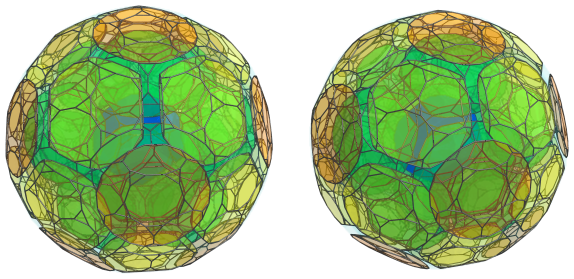4D Euclidean space
News Archive
March 2014
This is it. This is the grand-daddy of them all, the largest 4D convex uniform polytope, the omnitruncated 120-cell:
Known also as the omnitruncated 600-cell, this polychoron from the 120-cell/600-cell family of uniform polychora has a whopping 14400 vertices, 28800 edges, 17040 polygons, and 2640 cells! It is the largest member of its family, and also the largest among all the 4D uniform polytopes.
So head on over to the omnitruncated 120-cell page where we explore the structure of this beautifully intricate polychoron and account for every one of its 2640 cells. Full Cartesian coordinates are provided, as is customary.
With this Polytope of the Month, we have reached a landmark: we have now covered all of the 4D convex uniform polytopes! The fun is far from over, however. You may have noticed last month that a number of Johnson solids have been added. There is a reason for this! February 2014 turned out to be a very interesting month for the CRF polychora discovery project, where an entire class of CRF polychora—4D analogues of the Johnson solids—was discovered, with the unprecedented occurrence of the bilunabirotunda and the triangular hebesphenocorona as cells, previously thought to be very difficult to build 4D polytopes out of due to their irregular shape.
So stay tuned; some of these fascinating new polychora will be featuring as Polytope of the Month in the upcoming months. Along the way, we may also throw in a few other bonuses as well, such as some of the more interesting 4D Catalans (duals of the uniform polychora).
22 Mar 2014:
Updated the links page to include John McIntosh's 4D Blocks game, an amazing Java game that takes you to an actual 4D world in first-person perspective, where you can move around, pick up blocks and build them into larger structures, and even follow a cute little 4D train that moves around a train track. Highly recommended!
13 Mar 2014:
Added a cool animation to the bilunabirotunda page, showing its relationship with the icosahedron:

1 Mar 2014:
The polytope of the month for March 2014 is up!
February 2014
Allow us to introduce this month's polytope:
This beauty is another of those amazingly intricate uniform polychora from the 120-cell/600-cell family of 4D uniform polytopes. It has 7200 vertices, 14400 edges, 9120 polygons, and 1920 cells. Of the 9120 polygons, 2400 are triangles, 3600 are squares, 2400 are hexagons, and 720 are decagons. Of the 1920 cells, 120 are great rhombicosidodecahedra, 1200 are triangular prisms, and 600 are truncated tetrahedra.
So head on over to the cantitruncated 120-cell page and admire the intricate beauty of this polytope. As usual, we provide full Cartesian coordinates for the 7200 vertices.
27 Feb 2014:
Added the pentagonal cupola (J5), the fifth Johnson solid.
25 Feb 2014:
Added more projection images of the bilunabirotunda (J91).
Added the triangular cupola (J3), a Johnson solid.
19 Feb 2014:
Added the triangular hebesphenorotunda (J92), the last Johnson solid in Norman Johnson's list.
Added the pentagonal rotunda (J6), yet another Johnson solid.
18 Feb 2014:
Added the metabidiminished icosahedron (J62), one of the Johnson solids.
Added the bilunabirotunda (J91), another one of the Johnson solids.
3 Feb 2014:
We're getting back to speed with our monthly updates here: the Polytope of the Month for February is now up!
January 2014
We're back! In spite of the fact that Real Life intervened last year, and the site was not updated for the latter half of the year, we finally got our act together and now we bring you the long-awaited next polytope on our list, the runcitruncated 120-cell!
This beautiful 4D polytope is one of the uniform polychora from the 120-cell/600-cell family of 4D uniform polytopes, and has an intricate surface made of 120 truncated dodecahedra, 720 decagonal prisms, 1200 triangular prisms, and 600 cuboctahedra. Pictured above are the 45 truncated dodecahedra that lie on the near side of the polytope to the 4D viewpoint.
Be sure to check out the runcitruncated 120-cell page, where we detail its structure and account for every cell. Full Cartesian coordinates are provided.
26 Jan 2014:
The next featured polytope is up! We apologize for the lack of updates in the latter half of 2013; Real Life intervened and we were not able to keep up with the updates. Nevertheless, we bring you the another beautiful member of the 120-cell family of uniform polytopes to begin 2014!







